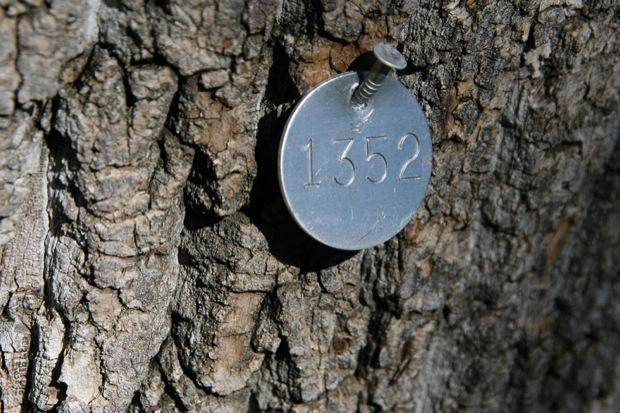
Walking through campus, one cannot help but notice all the trees here. Big and small trees; oak, pine, and palm trees; orange trees, the list goes on and on. But has anyone ever stopped to wonder how the school keeps track of how many trees there are on campus?
Professor of geography and director of the Institute for Sustainability, Helen Cox, along with other geography students, have taken on the task of tagging the estimated 3,800 trees planted throughout CSUN since April 2009.
Cox explains that tree tagging is the process where they go up to a tree and tag it with a special kind of aluminum nail with its own ID number, its size and its species. They also measure the diameter of the tree. The information is then entered into a database and mapped on a GIS system (Geographical Information System), which works similarly to Google Maps.
“We input the information of the coordinates and the position of the trees on a map. So then we have a map of campus with every tree located. If you click on a tree, it would tell you the tag number, the size of the tree, and the species,” Cox said.
Cox explained that she chose to tag the trees because of two things. First, her interest in carbon sequestration, which is catching the excess carbon dioxide from the atmosphere, condensing it, and storing it in a gentle way. Cox said she also wanted to find out how much a tree sequesters, how many trees are on campus, and how many tons of carbon dioxide can be accounted for.
Second, she found a plan atlas, which was produced by a professor in the geography department dating back to 1989. In this atlas, all the trees were identified and mapped out.
However, Cox explained that the problem with the atlas is that it was done before the 1994 Northridge Earthquake and many things had changed since that time. Not being much use to anyone, Cox decided to do a new tree atlas.
Cox then brought the idea to the Core Greening team, made up of faculty members and administrators that work in different areas around CSUN. After receiving the funding, students were paid to tag the trees.
Among the students working this semester are Roger Motti and Areeya Tivasuradej.
Tivasuradej, 20, who’s graduating in December, joined after going to a conference at the Institute of Sustainability, where Cox was discussing making a tree inventory to calculate CSUN’s carbon footprint.
Since she had interest in the subject matter, Tivasuradej decided to sign up.
Tivasuradej worked with two other students and spent a week tagging trees in the Orange Grove.
“There are like thousands and thousands of orange trees right there. I mean when you walk pass by it, you don’t know how many. You just go, ‘Oh, how many orange trees’ but when you actually tag every single tree, it’s like wow, we have a lot,” said Tivasuradej, a geography major.
Motti explains that after having Cox as a professor for many semesters, working for her at the Institute for Sustainability, and having an interest in environmental topics, he decided to work in the tree-tagging project. Motti has personally tagged about 500 trees.
When out tagging trees, Motti said they carry books with them to help identify the trees.
“We collect things like a seed, that could be a pinecone or that could be a cherry or a berry, or a leaf. Or maybe a small piece of a branch where the leaf connects. With those we can pretty much figure out what most of them are because we have a really good biology department,” said Motti, a geography major.
The students not only tag the trees with an ID number, but they also measure them because different trees grow at different rates. Motti explained that once the measurement is taken to see how big it is, and based on what kind of tree it is, they can tell how fast the tree grows and how much carbon dioxide is taken in.
However, some trees are not tagged, and this may be because they are expensive or because they are of a special type, like the ones located in the botanical garden, which include some palm trees.
In order to keep record of the trees not tagged, Motti said they place a dot on an aerial photograph taken of the tree and write down a number to see which tree is.
However, according to Motti, this can be difficult when there are several trees next to each other. And a lot of the time they have to go back and retag the trees because some students are pulling the tags off of them, Motti said. He urges students to stop doing that.
Besides the tagging, Cox has spoken to CSUN about the possibility of minimizing its water usage and by choosing to use drought-tolerant trees.
“They’re actually very interested in putting in drought-tolerant species and more native species also. So as they go forward for their new plans, they are taking those things into consideration,” Cox said.
The purpose for tagging the trees is for maintenance, Cox explained. So if there’s a problem, it’s easily located by its ID number.




